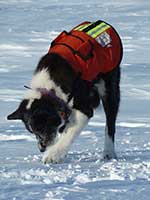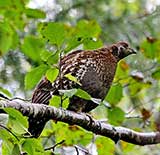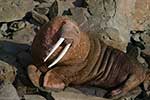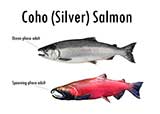Alaska Fish & Wildlife News
May 2015
Detecting Grizzly and Polar Bear Dens
on Alaska's North Slope

U.S. Fish and Wildlife Service biologist Craig Perham was sitting on his snowmachine taking notes when he was surprised by Karelian Bear Dog, “Kavik,” trotting resolutely by, heading up the nearby slope. Kavik’s owner, ADFG biologist Dick Shideler, had just unloaded him from the Hagglunds tracked vehicle and was preparing Kavik’s work vest when the dog pulled away and took off upwind toward the nearby ridge 300 meters away.
Shideler and Perham were searching ... Finding bear dens Article Continued
The Hooter Obsession

The chicken-sized grouse of Southeast Alaska that inhabit the Tongass National Forest are called “sooty grouse” and used to be called “blue grouse” by nerds like wildlife biologists who pay attention to what someone in an ivory tower considers the bird’s “proper common name.” These birds are known by locals in Southeast Alaska by one name, and one name only: hooters.
From late March through June, the males of these biggest of Alaska grouse fly ... The Hooter Obsession Article Continued
State to Open Round Island with Help
from Donors, Federal Grant

Round Island, the widely photographed centerpiece of Alaska’s Walrus Islands State Game Sanctuary, will be in full operation this summer and open to visitors thanks to donations from a group of private partners dedicated to the study and conservation of walrus, and a federal grant.
Funding for the Round Island program was eliminated last year after declining oil revenue resulted in state budget cuts. In the wake of public concern that the Round Island program continue, donations were ... Round Island is open Article Continued
Alaska’s Five Species of Pacific Salmon
Lifecycle and Identification

There’s an easy way to remember the names of each of Alaska’s five different species of Pacific salmon. It’s a method we often use when educating young kids about the different species and the salmon lifecycle. And it works.
We ask kids to hold one hand up and spread their fingers. We motion to the thumb and say, “Thumb rhymes with chum.” Then we ask them to use their pointer finger and point to their eye. “Point to your eye. Eye rhymes with sockeye.” ... Alaska Salmon ID Article Continued
